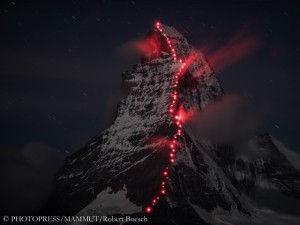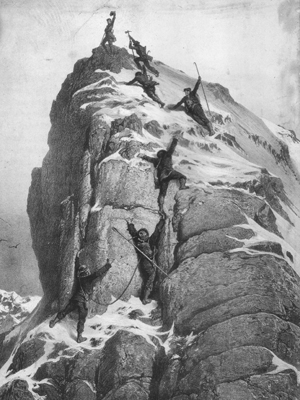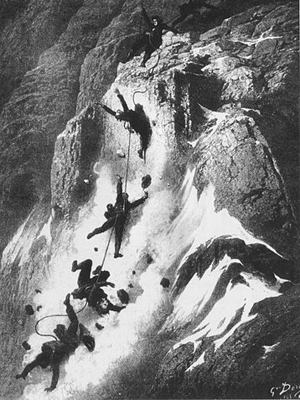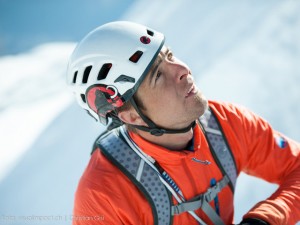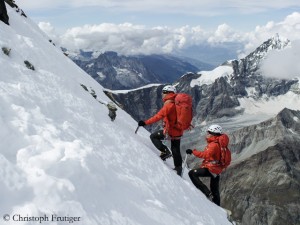150 years ago: Triumph and tragedy on the Matterhorn
The clock is running. In a week from now, the countdown clock on the station square in Zermatt will jump to zero. On 14 July, exactly 150 years ago, the Matterhorn was first climbed. No other mountain in Switzerland embodies the country more than this shapely four-thousander. And that’s not just because of a famous chocolate brand that is sold around the world, the bars of which modeled like the Matterhorn. Every year, 2,500 to 3,000 climbers try to reach the 4,478-meter-high summit – most of them via the Hörnli Ridge, the normal route that was also taken by the first ascenders headed by the Englishman Edward Whymper. The Hörnli Hut at 3,260 meters, starting point of most aspirants, has been rebuilt and modernized at great expense. In time for the Matterhorn anniversary it was finished. On the day itself, the mountain should be left in peace. Therefore the Matterhorn will be closed for ascents on 14 July – in order to remember all the people who died on the mountain.
In the ninth attempt
More than 500 climbers have so far lost their lives on the Matterhorn – among them four of the seven first ascenders. It was the most famous mountain tragedy of the 19th century. The first ascent of the Matterhorn was the number one in the ranking of the mountain projects in the 1860s, comparable with the first ascent of Mount Everest in the 20th century. Each climber knew: The one, who was able to climb the prestige mountain first, would not only write Alpine history, but would become famous worldwide. The project evolved into a race between the Briton Edward Whymper and the Italian Jean-Antoine Carrel. First both failed eight times on the Matterhorn, in some of the attempts together.
Faster approach
In that week of July 1865, Carrel ascended from Italy via the Lion Ridge. By then Whymper had also taken this route. But when he heard that Carrel had already set off for his potentially decisive summit attempt, he engaged with the proposal of mountain guide Peter Taugwalder senior from Zermatt who thought that it was possible to climb via the Hörnli Ridge. Whymper, Taugwalder and his son Peter junior, the French mountain guide Michel Croz and the Britons Lord Francis Douglas, Charles Hudson and Robert Hadow were the members of the rope team. Taugwalders route via the Hörnli Ridge proved faster. At 1.40 p.m., Whymper reached the summit. When Carrel saw the roped party at the highest point, himself being about 400 meters lower, he was very disappointed and turned back.
One victim still missing
On the descent of the successful rope team, the tragedy happened: Hadow slipped and pulled Douglas, Hudson and Croz with him. Quick reacting, Taugwalder senior wrapped the rope around a rock – in vain. “The rope snapped, as if it was only a piece of string, and the four young men were no longer visible. It happened so quickly as a lightning”, Taugwalder junior wrote later. The four unfortunate climbers fell down the North Face to death. Three bodies were recovered in the following days. Lord Francis has remained missing until today – and with him one end of the snapped rope. The other can be seen today in the Matterhorn Museum in Zermatt. This autumn, there will be another search for Douglas at the foot of the Matterhorn North Face.
Low blow
The three survivors – Whymper and the two Taugwalders – faced fierce criticism. Whymper later accused Taugwalder senior to have used deliberately the thinner rope between him and the others. The mountain guide career of Taugwalder ebbed away because he could not find foreign clients any more. “Whymper had no respect for the mountain guides”, the living climbing legend Reinhold Messner told the Swiss newspaper NZZ. “He didn’t even thank Taugwalder for saving his life by wrapping the rope around the rock at the moment of the fall.”
Carrel’s death on the Matterhorn
On 17 July, just three days after Whymper’s summit success, Jean-Antoine Carrel succeeded in making the second ascent of the Matterhorn via the Lion Ridge. The race for the first ascent of the mountain did not divide Whymper and Carrel. Later they went together on expedition to South America. In 1880, they made, inter alia, the first ascent of the 6267-meter-high Chimborazo in Ecuador. In 1890, Carrel’s life ended – at the Matterhorn. After a sudden fall in temperature, he succeeded in bringing his companions through the deep snow to safety, but then he died of exhaustion.
P.S. On the occasion of the Matterhorn anniversary, you can read here on my blog in the next few days three interviews. In each of them only the first and last question are identical. The Matterhorn from three perspectives: that of a mountain guide, a mountain rescuer and a professional climber. I hope I’ve made you curious. 😉



